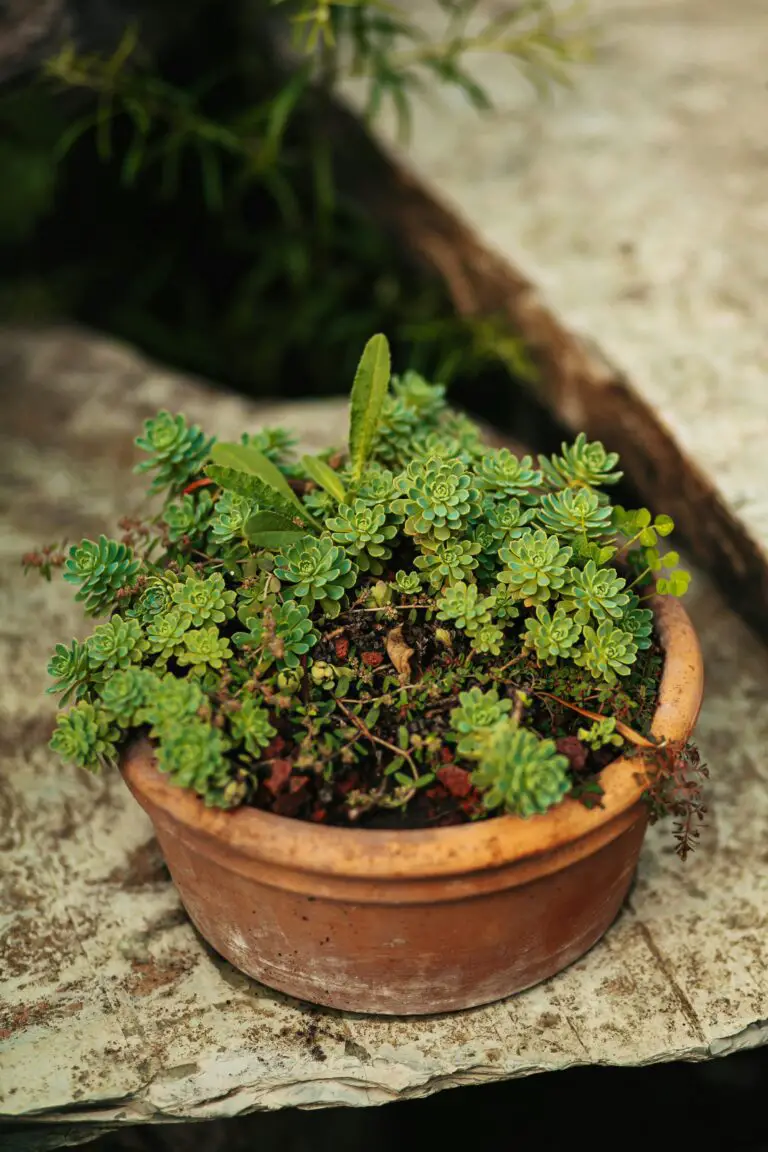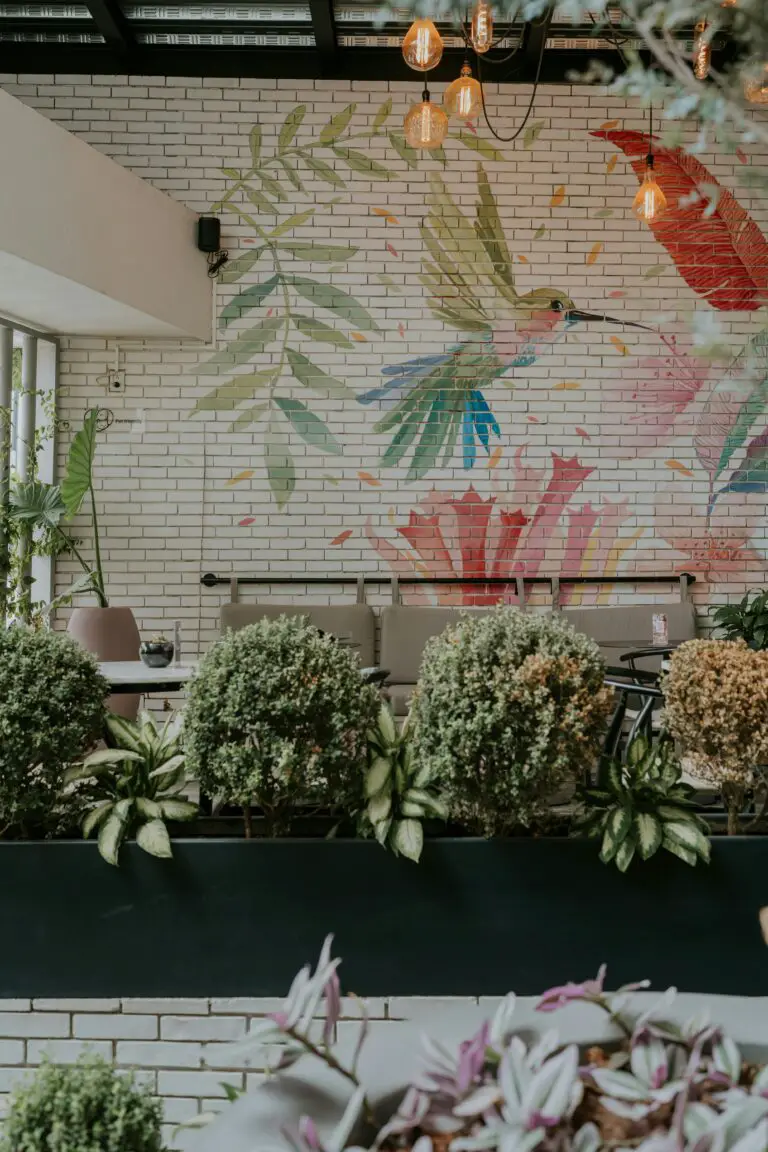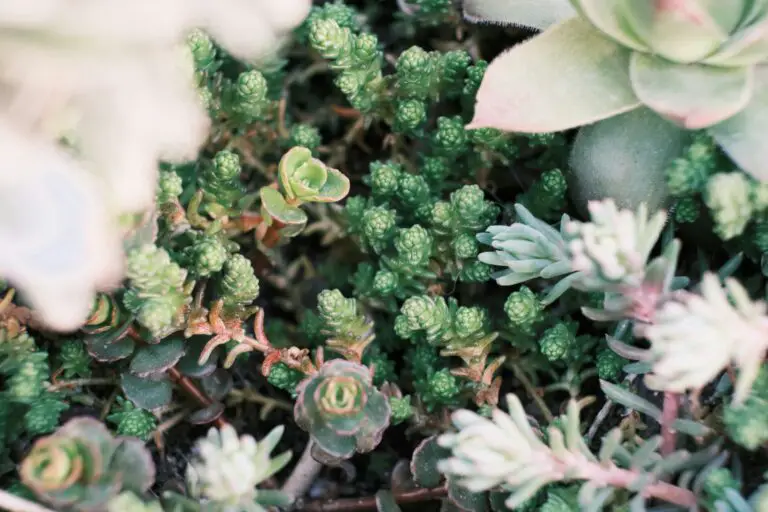Introduction to Sedum: Unveiling the Basics
Imagine stepping into a world where foliage morphs into vibrant colors as the seasons change, where blossoms sparkle like stars against structured, succulent leaves. This isn’t the stuff of fairytales, but the real-life magic of sedum, a cherished gem in the tapestry of gardens and landscapes. But what exactly is sedum? Let’s dive into the basics.
Originating from the cradle of diverse ecosystems, sedum, or stonecrop as it’s fondly called, is a succulent that has garnered widespread acclaim for its hardiness and ornamental beauty. With a lineage that spans the globe, sedum has woven itself into the fabric of various cultures, each with their own tale to tell about this adaptable plant.
Commonly recognized by its thick, fleshy leaves that store water, sedum is a survivalist’s dream. It’s capable of thriving in challenging environments that would see other plants wither away. From the alpine heights where the air is thin to the robust urban gardens, sedum stands as a testament to resilience. This characteristic is why sedum is an undeniable favorite among both beginners and seasoned horticulturists.

But sedum isn’t just one note. It plays out in a symphony of varieties, each with its own distinctive flair. Whether it’s the star-shaped ‘Autumn Joy’ that sets the autumnal garden ablaze with its deep rosy hues or the ground-hugging ‘Dragon’s Blood’ that carpets the earth with its ruby splendor, sedum is a chameleon of the plant world. Embracing a vast array of shapes, sizes, and colors, sedum is a master class in versatility.
Let’s not forget, its popularity isn’t all about ruggedness and appeal. Sedum’s practicality extends beyond the leafy spectacle. It’s a favorite among bees and butterflies, acting as a beacon of sustenance and contributing to the ecological ballet that sustains our world. By bringing sedum into your space, you invite a snippet of wildlife to grace your green haven.
So as we peek under the leaves of this botanical wonder, we uncover a story of wonder, diversity, and ecological harmony. It’s clear that sedum isn’t just another plant, it’s a narrative, one that adds a profound depth to the meaning of a garden. As we progress through our botanical odyssey, remember that sedum isn’t just living decor; it’s a profound statement of what it means to be resilient, adaptable, and simply beautiful.
The Language of Flowers: Sedum’s Special Meanings
In the quaint and curious realm of horticulture, every plant whispers its own tale with its very existence, its blossoms unfurling secrets, and its foliage enshrining lore. Among these green raconteurs, sedum, a genus of hardy, succulent performers claiming their niche in rock gardens and rooftops, signs a language all its own in the floral lexicon. Their meanings, nestled in historical roots and cultural significance, speak sentiment without a voice, grace without a gesture.
But what stories and traditions emboss the essence of these tough yet tender botanicals? Think of a sedum peeking through a crannied wall, its plump leaves and star-shaped blooms a symbol of resilient love. Picture the tradition-bound gardens of Asia, where sedum holds a place of honor, whispering token tales of tranquility and stoic beauty amidst the artfully arranged stones. In Europe, its presence hinted at peace, calm, and eternal love, a close companion in cottage gardens and folk medicine alike. Learn more about sedum’s historical use in traditional remedies.
Embracing sedum in your garden does more than create a vista of varied textures and hues; it weaves a seamless thread with the past, aligning modern-day cultivation with narratives that have withstood the tumult of ages. In a world bristling with transience, sedum serves as a steadfast symbol of endurance and timelessness. It’s not just a plant; it’s a testament to survival and the power of narratives rooted deep in the soils of history.
Undoubtedly, delving into the cultural canvas, one encounters sedums in the storied hangings of myths and traditions. These, too, play a pivotal role in the meanings a garden accrues, imbuing a space with more than the sum of its parts, but rather, with the spirits of the stories it tells. See how sedum integrates into time-honored gardening practices.
Enabling a gander into the timeless eloquence of plants, sedum continues to be a gem in the gardener’s chest. Whether viewed through the prism of history, culture, or sheer aesthetic pleasure, these succulent wonders channel an age-old dialogue, resonating through every sepal and reaching across every stamen. Witness the narrative of sedum and its place in the traditional and contemporary mise-en-scène.
Join us in gesturing towards the remarkable sphere where plant language flourishes; let the gem-like petals of sedum recount their resilience and perennial allure within your garden’s embrace. Plant a sedum, and you’re not simply planting greenery; you’re scripting a saga of survival and significance, nourishing a narrative as old as cultivation itself.
Sedum Varieties and Their Unique Significance
Within the vibrant tapestry of your garden, sedum plants stand out as robust, low-maintenance succulents that bring not just beauty but also symbolism to your green haven. Each variety of sedum – or stonecrop, as it’s affectionately called by devotees – comes with its own storied meaning, offering a rich narrative to those who understand its language. So, let’s dig into the diverse world of sedums and unearth what each type signifies.
Take the ‘Autumn Joy’ sedum, for example. This variety, with its robust, fleshy leaves and thick, broccoli-like blossoms, shifts from a warm pink to a rich rust color as summer fades into fall. This evolution is emblematic of transformation and adaptability, resonating with gardeners who appreciate change and resilience in their floral companions.
On the other end of the spectrum, we find the ‘Dragon’s Blood’ sedum. With its deep red leaves that seem to intensify with the sun’s attention, this variety is often associated with strength and enduring love. It’s a popular choice for gardeners who wish to add a dash of passion and vitality to their landscapes.
Now, picture the delicate ‘White Diamond,’ a sedum that sprouts pure white blossoms giving the impression of a dusting of snow across your garden bed. This variety is often seen as a symbol of clarity and innocence, making it a heartfelt gift to those starting anew or celebrating a fresh chapter in life.
The visual diversity among sedum plants is matched by their symbolic versatility. Some gardeners believe that the ‘Gold Mound’ sedum, which glows with yellow-green foliage, attracts wealth and positive energy. While others find solace in the calming presence of the ‘Blue Spruce’ sedum, whose blue-gray foliage resembles the tranquil needles of its namesake tree, symbolizing serenity and grounding.
Gardening is not just about planting; it’s about cultivating meaning. And understanding when to plant these sedums ensures that you can appreciate their full symbolism as they flourish in your care. For more on optimizing your garden’s potential, consult our garden care tips for nurturing these succulent treasures.
As you weave these varieties into the fabric of your garden, remember that sedum is more than just another plant; it’s a storyteller, a symbol, and a silent companion in your journey through the seasons. Each one, with its unique hues and textures, not only adds visual interest but also brings a layer of meaning to your curated oasis.

Gardening with Intention: Planting Sedum for Meaning
Imagine strolling through a garden where each plant tells a tale, a space meticulously crafted to narrate stories of growth, resilience, and beauty. This is the magic woven into your green haven when you plant sedum with intention. Not merely vibrant ground cover, sedum carries a symphony of meanings, ready to enrich your garden narrative.

When you choose a spot for your sedum, you’re scripting a message. Place it at the garden’s edge to signify a hardy boundary, resilient to the trampling of life’s occasional roughness. Tuck it in rocky nooks to speak of beauty thriving in the midst of adversity. Or let it cascade over walls, telling a tale of overflowing abundance.
Speaking Without Words: Sedum’s Silent Dialogue
Pair sedum with companions that enhance its narrative power. Nestle it alongside lavender to invoke a sensory experience of calm, or juxtapose it with bold sunflowers as a nod to the contrast between the sun’s fiery energy and sedum’s cool resilience. The act of companion planting goes beyond aesthetics; it’s like composing a poem in which each plant is a carefully selected word, contributing to a greater message.
Themed Gardens: Crafting Stories in Nature’s Tapestry
Envision a garden where each section is a chapter, a separate vignette within a larger story. A corner dedicated to meditation might feature sedum in calm blues and greens, promoting tranquility. A children’s garden could burst with colorful sedum varieties, symbolizing joy and whimsy. By considering the symbolic meanings of sedum, you curate spaces that resonate with your gardening intentions, transforming your landscape into a living narrative.
Through thoughtful placement, intentional companion planting, and the creation of themed gardens, sedum becomes more than just foliage; it’s a botanical storyteller, an emblem of the messages you wish to whisper to the souls wandering through your personal patch of paradise. Plant sedum with purpose, and watch as the canvas of your garden flourishes into a masterpiece of meaning.
Care Tips for Sedum: Ensuring Your Plant Thrives
Fancy making your garden’s sedum the envy of plant enthusiasts everywhere? It doesn’t take a green thumb—just a bit of know-how and attention to detail. Let’s dive into the essentials of sedum care, so you can watch these succulent beauties flourish!
The Right Soil Mix: A Foundation for Success
First things first—the soil. Sedum plants adore well-draining soil, as their roots are prone to rot if waterlogged. A mix of potting soil with sand, perlite, or pumice ensures swift drainage and a happy plant. Remember the adage, “Right plant, right place”? Well, the right soil mix is your sedum’s best starting block.
Making a Splash: Watering Wisdom
When it comes to watering, think of your sedum as the camel of the plant world—it can survive drought, but appreciates a drink. The key is a thorough watering only when the soil has dried out, typically every 7-10 days. The ‘soak and dry’ method is your go-to here. It’s less about a schedule and more about feeling the soil and observing your plant’s demeanor.
Bask in the Glory: Sunlight Requirements
Sunlight is another crucial piece of the puzzle. These plants need a solid block of sunshine each day—around 6 hours of direct light—to develop their vibrant colors and sturdy stems. Partial shade will do in scorching climates, but too much shade leads to a leggy, less spectacular sedum.
The Pruning Touch: Keeping Sedum Shapely
Pruning isn’t just for roses! Trimming sedum promotes a fuller, bushier growth habit and keeps it from becoming too leggy—especially if it’s not getting enough light. Snip away any stretched stems, and consider propagation to multiply your sedum stock. It’s a great way to keep your garden bursting with life!
And, speaking of propagation and pruning, let’s take a little detour into a visual learning experience. Have a look at this informative video that provides some great tips on taking care of sedum, particularly focusing on trimming and propagation techniques that can really make a difference. You don’t need to feel overwhelmed; managing your sedum can be as enjoyable as the blooms they bear!
One last tip: Start these care routines early in the season to help your sedum become a robust, resilient part of your garden that’s capable of withstanding pests and varying weather conditions. A stitch in time saves nine, and the same goes for plant care—preventative measures are always better than a cure!
Sedum in Modern Culture: Beyond the Garden
When we think of sedum, often the image of lush, hardy garden beds come to mind. But the significance of this versatile plant stretches far beyond the confines of our backyards. In contemporary times, the interpretation of sedum’s meaning has woven its way into the very fabric of art, design, and modern cultural symbolism. Consider the rise of sedum as a mainstay in home decor trends—it finds its way onto shelves and desks as a low-maintenance and aesthetically pleasing touch of greenery.
Architecturally, the use of sedum has been elevated to new heights—quite literally. With the advent of green roofing, sedum varieties have become a go-to choice, creating eco-friendly, insulating roof coverings that not only reduce heat islands in urban settings but also provide a visually appealing roofscape.
In the realm of design, sedum inspires artists and creators with its multitude of shapes, colors, and sizes. This adaptability allows for the plant to be a recurrent theme in modern artwork, symbolizing resilience and an effortless meld with the contemporary ethos of blending functionality with beauty. One perfect example is its incorporation into living walls, where structured art meets practical sustainability.
To delve deeper into the influence of sedum in modern architecture, there are exemplary projects where the integration with urban spaces tells a greener story. Public buildings and private homes alike are increasingly featuring sedum not just as an afterthought, but as an intentional, intrinsic part of design for the future. Here’s an insightful read that showcases how sedum is changing the face of contemporary outdoor spaces and becoming a staple in green building.
As we continue to reimagine our living and working environments, sedum’s prominence grows. It has become symbolic of a movement towards more sustainable, mindful living. This reinvention and recontextualization of sedum demonstrate the plant’s significance as not only a garden fixture but also a cultural icon that reflects the zeitgeist of modern design and ecological awareness.
Frequently Asked Questions
When it comes to creating living tapestries in our gardens, few plants are as versatile and delightful as sedum. Known for their succulent leaves and robust nature, sedum plants are a staple in spaces ranging from rustic alpine gardens to modern urban balconies. If you’re curious about how to get the most out of these charming plants, you’re in the right place. Let’s dive into some of the questions that garden enthusiasts often ponder.
What does sedum symbolize in garden design?
Throughout history, sedum has been imbued with symbolism that varies across cultures and contexts. Often, sedum represents resilience, due to its ability to withstand drought and poor soil conditions. In a garden setting, incorporating sedum can signal a dedication to sustainability and a celebration of endurance. Consider a garden visitor who spots a spray of sedum peeking out from a rocky crevice, a tangible testament to the plant’s tenacity and the gardener’s ingenuity.
How should I care for my sedum plants?
Caring for sedum is a breeze, making them favorites among both green thumbs and those new to gardening. For the most part, sedum thrives on neglect rather than pampering. They prefer well-draining soil and plenty of sunlight, though they can also adapt to partial shade. Watering should be infrequent, allowing the soil to dry out between waterings. Imagine a sedum’s leaves like tiny reservoirs, hoarding water for the dry spells; they’re the camels of the plant world!
Can you tell me about different varieties of sedum?
One of the joys of cultivating sedum is exploring its vast array of varieties. From the ground-hugging ‘Dragon’s Blood’ with its crimson foliage to the stately ‘Autumn Joy’ that offers late-season blooms, there’s a sedum out there for every garden scenario. Picture a rock garden, each nook and cranny occupied by a different variety of sedum, playing with textures and colors in a symphony of fleshy leaves and star-shaped flowers.
Any tips for incorporating the symbolism of sedum into my garden?
Symbolism in the garden is a personal journey, often shaped by your own experiences and aspirations. To mirror the resilience of sedum, you might pair it with other drought-tolerant plants, creating a narrative of strength and survival. Or, use sedum as a groundcover to symbolize unity and interconnectedness. Envision a pathway in your garden, bordered by sedum, guiding you through a landscape of purpose and connection.




